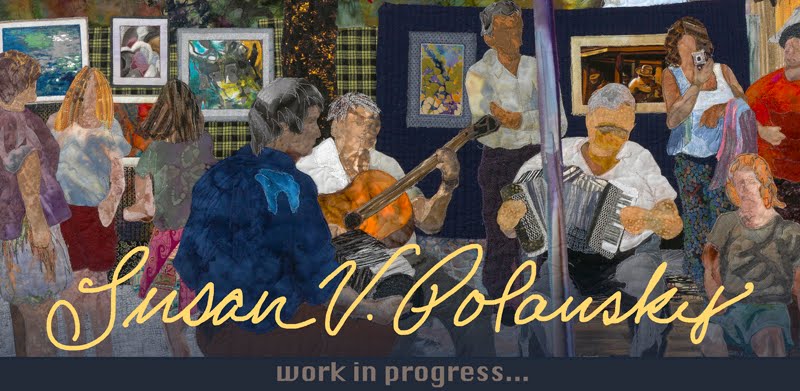My last post talked about spontaneity and planning. Spontaneity can be fun and exciting, or disappointing and discouraging. Planning can be exciting also, but the fun of it can be mired down into drudgery and result in lifelessness. To achieve a combination of the two is my ideal.
How does my creative process lend itself to these opposing forces?
 |
"Never Mind the Execution"
Susan V. Polansky, 2001
|
The best answer is to look at an overview of all my work. I never repeat the same thing. In fact, before I ever started using fabric, a college professor wanted me to work in a series. I just couldn't do it. Every painting I did was a "and now for something completely different!" I don't like templates, patterns, variations or the like. I don't get enough out of a re-do. There are many artists that hit upon a successful look, and they repeat that ad infinitum. They can streamline their technique, market the method, become known for their look.
 |
painted sneakers by
Susan Polansky
|
 |
God's Eye trials
Susan V. Polansky, 2006
|
Modern businesses have perfected the expected. Producing known outcomes is a safe business model. It probably started with production of the Model T, but post-war housing developments and fast food establishments took off and ran with the idea. A proliferation of uniformity creeps everywhere, even into areas where creativity and unique-ness thrived. We've all seen advertised: "Action Figure," "A.F. Returns," "A.F. Again!" and so on in the movies. And last I looked, I was surprised by how many adult book titles claim "(some number) of the (trilogy, series, saga.) Not that I haven't indulged in consumption of mass marketing! It's just not what I want for my art. However, having a guaranteed outcome is a much more reliable source of income! I am incredibly fortunate to have a supportive family, which allows me the freedom to spend time in my studio.
 |
Composition: My Reaction to School Violence
Susan V. Polansky, 1999
|
Over the years, I've experimented with many mediums. I'm curious as to how other artists work. I bring what I've learned forward into each new piece. I can draw from my bag o' tricks whatever technique might serve the piece best. That is how I get lost in the "process." I'm constantly having a dialogue with a work in progress, observing what is working and what needs to happen. I don't feel limited by sticking with any one way of doing something. And I'm not afraid of change. My spontaneity is not a quick burst, but rather a collection of intuitive choices of what "feels" right at the moment.























